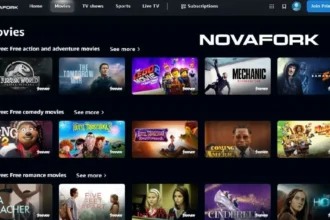Introduction to Red Lobster TGI Fridays Closing
The news of Red Lobster TGI Fridays Closing locations has sent ripples through the dining community. These beloved casual dining establishments have been staples for many, offering comfort food and a vibrant atmosphere. But as restaurant closures become more frequent, questions arise about what’s really happening behind the scenes. Are these closures mere casualties of changing consumer preferences, or do deeper issues lurk beneath? Join us as we dive into the unfolding story surrounding these iconic brands and explore the factors driving this trend in casual dining.
The Decline of Casual Dining Chains
Casual dining chains have long been a staple in the American food landscape. However, recent trends show a significant decline in their popularity.
Changing consumer preferences play a key role. Diners are increasingly seeking convenience and speed, often favoring fast-casual or takeout options over traditional sit-down meals.
Additionally, the rise of delivery services has reshaped how people enjoy their meals. Many now prefer dining at home rather than navigating busy restaurant environments.
Economic factors have also contributed to this shift. The cost of dining out continues to climb, pushing consumers to reconsider how they spend their money on food.
As more diners opt for unique culinary experiences outside chain offerings, casual dining establishments face an uphill battle for relevance in today’s market. This evolution reflects broader changes within society and its relationship with food culture.
Red Lobster & TGI Fridays Closing Stores: What’s Really Happening Behind the Scenes?
If you’ve walked past an empty Red Lobster or TGI Fridays in your neighborhood recently, you’re not alone. News about these popular restaurant chains closing more locations has left many customers and employees asking, “Why?” These restaurants, once synonymous with affordable indulgence and casual dining, are facing challenges that go deeper than what meets the eye.
This blog will take a closer look at what’s happening behind the scenes of Red Lobster’s and TGI Fridays’ closures, the issues driving these changes, and what it could mean for the broader casual dining industry.
The Rise and Struggles of Casual Dining Giants
Red Lobster and TGI Fridays are names that many associate with hearty dishes, friendly service, and memorable outings. For decades, they stood proudly in the casual dining sector, offering something for everyone. But now, years after reaching their peak, both companies are grappling with declines in foot traffic and profits.
Red Lobster’s Journey through Uncertain Waters
Red Lobster made its mark with endless shrimp, cheddar bay biscuits, and fresh seafood at accessible prices. At its height, the chain thrived in towns and cities across the U.S. But in recent years, the company has hit rocky waters.
Why is Red Lobster Struggling?
- Changing Consumer Behavior
Millennials and Gen Z increasingly favor fast-casual dining or meal delivery services, valuing speed and convenience over long sit-down meals. With fewer people visiting dining rooms, even long-standing brands like Red Lobster are taking a hit.
- Rising Operational Costs
From inflationary food prices to higher labor costs, running a seafood-focused restaurant chain has become significantly costlier. Certain core ingredients, like lobster and shrimp, have seen rising market prices, squeezing profit margins further.
- A Pandemic Hangover
While the COVID-19 pandemic dealt a major blow to the entire restaurant industry, Red Lobster has struggled to bounce back as quickly as some of its competitors. Many locations rely heavily on in-dining experiences, which have been slow to recover.
TGI Fridays and the Fight to Stay Relevant
TGI Fridays, with its upbeat atmosphere and signature dishes like loaded potato skins and Jack Daniels’ BBQ, was an industry pioneer in the world of casual bar-and-grill dining. But even a celebrated legacy isn’t insulation from the pressures of time.
Key Challenges for TGI Fridays
- Outdated Dining Experiences
While nostalgia can be a brand’s best friend, it can also hold it back. TGI Fridays has often been criticized for failing to modernize its spaces and menus as quickly as its competitors like Chili’s or Applebee’s, leaving it lagging behind in the battle for relevancy.
- Digital Transformation Lag
Many competitors in the restaurant space have embraced online ordering, customized apps, and loyalty programs. TGI Fridays, however, has been slower to adopt cutting-edge technology, potentially alienating digital-savvy diners.
- Declining Customer Loyalty
Over time, the perception of middle-tier dining chains as “nothing special” has grown. Coupled with stiff competition and evolving dining preferences, loyalty has waned.
What’s Really Happening Behind the Closures?
While both brands are dealing with distinct challenges, there are several intersecting factors contributing to their recent wave of closures.
1. Unfavorable Locations
Both Red Lobster and TGI Fridays have recognized the issue of maintaining underperforming locations, particularly in areas where foot traffic has dwindled. The high fixed costs of leases, utilities, and staff for empty tables have forced decisions to shut down some outlets for good.
2. Saturation Within the Sector
For years, the casual dining sector has been crowded, with restaurant chains opening too many locations during their peak growth years. The result? Oversaturation. This surplus of restaurants has cannibalized traffic, with fewer diners to go around.
3. Rise of Competitors
Meanwhile, fast-casual chains like Chipotle or Sweetgreen, which deliver a mix of affordability, convenience, and perceived health benefits, are eating away at the market share of traditional sit-down chains. Customers now lean toward customizable meals that can be grabbed on the go rather than committing to full-service dining.
4. Economic Pressures
The broader economy has added additional strain. Inflation, supply chain issues, and labor shortages have all driven up costs for restaurants, particularly those that rely so heavily on fresh, perishable ingredients like seafood.
Are These Closures the Beginning of the End?
Does this mean that Red Lobster and TGI Fridays are heading toward permanent extinction? Not necessarily. While these closures are concerning, some see them as strategic moves to better position these companies for the future.
Between efforts to streamline operations, focus on high-performing locations, and potentially reinvent their offerings, there’s room for optimism. Both brands have committed to reevaluating how they reconnect with a changing customer base, including experimenting with new menu innovations and smaller, more responsive restaurant formats.
What This Means for the Casual Dining Industry
The challenges faced by Red Lobster and TGI Fridays aren’t theirs alone. Industry-wide, casual dining needs to evolve to keep up with changing consumer tastes, behaviors, and emerging competition. Chains that successfully integrate modern dining options, advanced technology, and unique experiences will likely be the ones that not only survive but thrive.
Out of this turbulent time in casual dining, new trends are likely to emerge. The shift toward hybrid dining experiences (merging eat-in and takeout services) and a growing emphasis on sustainability and responsible sourcing are significant opportunities for those willing to adapt.
Closing Thought
While seeing once-beloved restaurants shutter their doors can feel like the end of an era, it’s also a powerful reminder of how industries must constantly evolve. For brands like Red Lobster and TGI Fridays, these closures present an opportunity to rethink their identity and adapt to new dining habits.
Consumers still crave great food, memorable experiences, and meaningful connection with their favorite brands. Whether Red Lobster and TGI Fridays will rise to the challenge remains to be seen, but one thing is certain—we’re all watching closely.

















